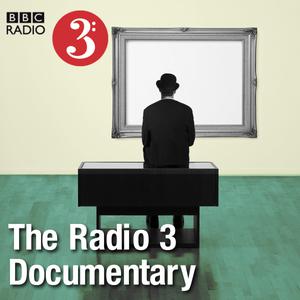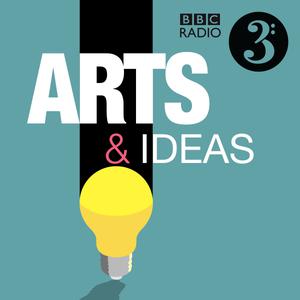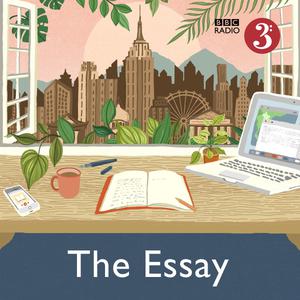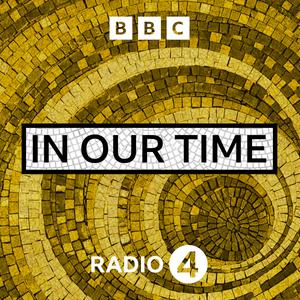
The Radio 3 Documentary
BBC
Exploring different aspects of history, science, philosophy and the arts.
- 43 minutes 41 secondsTime Canvasses - Morton Feldman and Abstract Expressionism
In a remarkable moment after WWII New York became the centre of the art world, simultaneously seeing the development of new ways of hearing music, and new ways of seeing art. It was here that the American experimental composer Morton Feldman said, “What was great about the fifties is that for one brief moment - maybe, say, six weeks - nobody understood art. That’s why it all happened”. The composer Samuel Andreyev shows how composers and artists in New York in this period went about the difficult business of wrestling with a new abstract language, often at great cost to themselves, to produce some of the masterpieces of post war American art. Samuel focuses on the powerfully productive relationships that Feldman had with the abstract expressionists, Philip Guston, and Mark Rothko, who showed him by example how to set his sounds free, in the same way their paintings set colours free. Feldman even called his own compositions, ‘Time Canvasses’, where he said, he more or less primed the canvas with an overall hue of music. This is a clue to the unorthodox way Feldman’s music - which can be both very long, and almost always very quiet - remarkably blurs what we imagine to be the boundary between music and painting. A Soundscape Production, produced by Andrew Carter.
7 February 2024, 4:52 pm - 43 minutes 35 secondsTuner of the World
"For the next hour, I need your ears". It's 1974 and someone is trying to recruit you for a listening experiment on public radio in Canada.
Pioneering Canadian composer and soundscape maestro, R Murray Schafer really wants you to commit: "if you're just listening to this programme casually, you'd better turn it off right now".
This audio experiment was part of a series on the CBC - the Canadian Broadcasting Company, called Soundscapes of Canada, consisting of ten hours of soundscape montage, field recordings and lessons in listening. From Church bells, to birdsong, to car horns and an entire episode made up of people across Canada giving the sound recordist directions: this was 'slow radio' years ahead of its time.
The series was recorded and produced by The World Soundscape Project, a group Schafer set up to raise the importance of the soundscape in what he saw as a world of increasing noise, which had reached "an apex of vulgarity". The group went on to publish Soundscape: The Tuning of the World - a vast anthology documenting just about every kind of sound you could imagine - natural, human-made and technological.
R Murray Schafer was many things – Canada’s preeminent experimental composer of the 20th Century, an artist, novelist, educator, musicologist, historian, and environmental activist. Schafer was also a romantic, with a strong sense of Canadian identity, who preferred rural life with an uncluttered sense of place. Critics, and he had many, accused him of being abrasive, a luddite, and prone to cultural appropriation.
Above all though, Murray was a passionate listener, constantly pushing his message of an "ecologically balanced soundscape" by asking "which sounds do we want to preserve, encourage, multiply?" In this sound-rich documentary (best enjoyed with headphones) John Drever, Professor of Acoustic Ecology and Sound Art at Goldsmiths, University of London explores Schafer’s life and legacy, as the soundscape now has an ISO framework for consideration in urban design and planning in the UK and beyond.
Contributors: Hildegard Westerkamp, Barry Truax, Ellen Waterman, Claude Schryer, Lisa Lavia, Tin Oberman, Andrew Mitchell and Francesco Aletta. Soundscapes of Canada and Vancouver Soundscape material used with kind permission of the World Soundscape Project, Sonic Research Lab, School of Communication, Simon Fraser University, Canada.
Use of 'Crescendo' courtesy of Martyn Ware
Presented by John Drever Produced by Rami Tzabar A TellTale Industries production for BBC Radio 3
12 June 2023, 8:47 am - 28 minutes 34 secondsSupply Lines
Via ports and truck-stops, fulfilment centres and ring roads, Aidan Tulloch follows the supply chain and reimagines the journey an item goes on in the age of 24/7 delivery.
4 June 2023, 5:45 pm - 13 minutes 59 secondsNew Generation Thinkers: The Perfect Balance
Dr Anindya Raychaudhuri searches for different perspectives on the idea of balance.
15 May 2023, 3:07 pm - 44 minutesThe Pleasures and Pains of Denton Welch
Denton Welch lived the last years of his short life in Kent during the Second World War. His writing career took off in 1943 and in the same year he met his companion, Eric Oliver. His writing is mostly autobiographical and carries his readers from a childhood in Shanghai, boarding school in 1930s England, a near-fatal bicycle accident while he was in art college, a slow convalescence and, finally, to his years travelling about the Kent countryside, picnicking, exploring churches and observing rural life with an artist's eye. And a queer eye. His subtle and gently subversive descriptions of same-sex desire and sexual identity has thrilled and challenged his readers for eighty years.
His preoccupations include art and beauty as well as pain and death. His great ability as a writer is to draw characters - often based entirely on himself and those closest to him - with tiny details which spring to life on the page. These can be very funny, cruel, poignant or erotic. He wrote novels, stories and journals as well as working with art and poetry. Regan Hutchins has always been a fan of Denton's writing and he travels to the village of Hadlow in Kent, where Denton lived during the Second World War. There he meets Denton's would-be neighbours who show him the landscape that inspired the writer. Biographers, academics, film-makers and writers help to build a picture of a writer who has, for too long, been out of sight.
Producer Regan Hutchins Reader Rob Vesty With thanks to the Hadlow Historical Society. Sound supervision by Tinpot Productions.
A New Normal Culture production for BBC Radio 3
7 May 2023, 5:45 pm - 43 minutes 39 secondsThe Black Cantor
Known in Yiddish as Der Schvartze Khazn--the Black Cantor--Thomas LaRue Jones was an African American tenor who sang Jewish music in the early decades of the twentieth century. Famed for his soulful voice and perfect Yiddish pronunciation, he performed in synagogues and theatres across the Eastern United States and toured Germany, Poland and Palestine. But after his death in 1954, LaRue Jones disappeared from memory, leaving behind only one recording, made in 1923. Drawing on research by the veteran musician and producer Henry Sapoznik, Maria Margaronis unpacks the mystery of LaRue Jones' career. What drew him to this music? What does his life tell us about race, faith and identity in America a hundred years ago? And why was he so quickly and utterly forgotten?
LaRue Jones' story is entwined with the history of Newark, New Jersey, where he spent most of his life. Once known as the City of Opportunity, old Newark drew migrants from Europe and the American South in flight from persecution and searching for a new life. Blacks and Jews lived side by side in the city's poorer districts, absorbing each other's culture and musical traditions.
But by mid-century, Newark's Jews were moving out in search of the suburban dream. Black people, hemmed in by racism and housing segregation, were left behind in an increasingly impoverished city. Thirteen years after LaRue Jones' death, the Newark riots, or rebellion, sealed the division of the two communities. LaRue Jones, like the world that made him, was consigned to oblivion--until zealous research by Henry Sapoznik tracked down that one recording and LaRue Jones' unmarked grave, and raised the curtain on the Black Cantor once more.
Presenter: Maria Margaronis Producer: David Goren
23 April 2023, 6:30 pm - 13 minutes 49 secondsSunday Feature - Shakespeare's Brum Ting
Over a century ago, in 1881, the city of Birmingham purchased a copy of Shakespeare's first folio. It was to be the crown jewel of their new Shakespeare library, the brainchild of the first librarian George Dawson. From the outset it was to be the People's Folio, the property of the city's Free library. You can find the evidence stamped in red ink on many of the pages. That might seem like a defacement to some, but to Shakespeare scholar Islam Issa and members of the city's 'Everything to Everybody' project, it shows a profound commitment. In this feature Islam draws together the passion and belief of George Dawson and his fellow city fathers - Birmingham became a city in 1889 - with the voices and opinions of Birmingham today as expressed by people like the internationally acclaimed street artist Mohammed Ali. He's produced two school murals that have the Folio at the heart of the city's sense of itself. In the afterglow of the Commonwealth Games and the realisation that Birmingham's strength lies in its multi-cultural population, Islam points out that rather than some distant evidence of an elite and unfamiliar past, the time has come for the Folio to be celebrated from Sparkbrook to the Bullring and beyond.
Producer: Tom Alban
26 March 2023, 7:00 pm - 43 minutes 39 secondsX-Ray Vision: Rudolph Fisher in Harlem
Lindsay Johns makes the case for writer Rudolph Fisher's portraits of Black American life
19 March 2023, 6:46 pm - 43 minutes 28 secondsHeinrich Heine: The First Modern European
One day, three decades after the event, the German poet and man of letters, Heinrich Heine, stood on the site of the battle of Marengo, one of Napoleon's earliest and most important victories and had an epiphany - or he invented one for his readers: ""Gradually, day by day, foolish national prejudices are disappearing; all harsh differentiations are lost in the generality of European civilization. There are no more nations in Europe, only parties; and it is marvellous to see how these parties, for all their varying colouration recognize one another and how they understand one another, despite many differences in language."
This move past national differences would be a force for unalloyed good because, if Europeans could see themselves as a unified "civilisation" then their example would be a force that "could" lead to the liberation of the world from prejudice.
Well, he was a child of the romantic age, you can forgive his enthusiastic language but his vision anticipates the principles that created and still guide the EU.
The writer produced astounding amounts of work: poetry, verse dramas, and essays and letters while conducting love affairs and just generally being in the public eye.
His poetry became the lyrical basis for lieder by Schubert, Schumann and many others. He had huge appeal in the middle of the 19th century. George Eliot wrote four monographs about him including one on his wit - bitterly ironic ,very Jewish.
Today he is remembered in the English speaking world for this quote, "Where they burn books, they will, in the end, burn human beings too." When the Nazis held their book burnings outside the Berlin Opera House, Heine's were among those immolated. And when the Nazis initiated the war that would burn down a significant portion of the Europe Heine dreamed of, the connection to much of 19th century German culture was cut including the life and work of Heinrich Heine.
Michael Goldfarb tells the story of Heine's life and the Europe in which he lived through interviews and using the musical settings of his poetry in lieder, readings from his poetry and plays, and George Eliot's perceptive comments.
Heine's was a tremendous life - he endured censorship and was harassed by the police spies of the Federated German speaking nations. He lived as a celebrity - albeit an impecunious one - despite the fact his uncle was one of the German-speaking world's richest men. All the drama created a truly contemporary, 21st century sensibility
Producer: Julia Hayball Readers: Jonathan Keeble, Robbie Stevens, Clare Corbett and Pavel Douglas Sound design: Chris Maclean
A Certain Height production for BBC Radio 3
13 March 2023, 11:09 am - 43 minutes 27 secondsGovernment Song Woman
American musician Rhiannon Giddens investigates the fascinating life and recordings of the folk song collector Sidney Robertson Cowell. Travelling thousands of miles all over the US in the depression era, Cowell was willing to track down songs in unlikely places, once writing "I don't scare easily." She spent a night riding in a hearse in Wisconsin just to question the driver and hear his songs, walked up mountains to record lumberjacks and traditional Appalachian singers and poled three miles downriver after dark on a makeshift raft to find a famed fiddler in his goldmine in California.
Listening to her recordings is like travelling back in time; they capture the voices of so many different nationalities that emigrated to the US, but she also made recordings on the Aran Islands in Ireland. During her lifetime Cowell was marginalised like so many women collectors of that period, but in this celebration of her recordings and observations, Giddens finally gives her work the attention it deserves.
With indebted thanks to the American Folklife Center archive in the Library of Congress who hold the collection of Sidney Robertson Cowell's recordings and to the following contributors who have done so much to bring her work to light:
Cathy Hiebert Kerst, folklorist and archivist who catalogued Sidney's recordings of the WPA California Folk Project.
Sheryl Kaskowitz, scholar of American music and author of forthcoming book: The Music Unit: FDR's Hidden New Deal Program that Tried to Save America from the Great Depression—One Song at a Time.
Jim P Leary, a folklorist and scholar of Scandinavian studies, and a professor at the University of Wisconsin–Madison, author of Folksongs of Another America.
Dr. Deirdre Ní Chonghaile writer, researcher and musician (she plays fiddle with Rhiannon at the end of the programme) who has written about the collecting work of Sidney Robertson Cowell on the Aran Islands in the 1950s.
Robert Cochrane, Professor of English and folklore specialist at the University of Arkansas.
Peggy Seeger, folksinger.
California Gold: Northern California Folk Music from the Thirties Collected by Sidney Robertson Cowell: https://www.loc.gov/collections/sidney-robertson-cowell-northern-california-folk-music/about-this-collection/
Producer: Clare Walker
5 March 2023, 7:20 pm - 43 minutes 21 secondsTutu - A Portrait of Nigeria
Chibundu Onuzo tells the fascinating story of ‘Africa’s Mona Lisa’ and artist Ben Enwonwu
12 February 2023, 7:30 pm - More Episodes? Get the App
Your feedback is valuable to us. Should you encounter any bugs, glitches, lack of functionality or other problems, please email us on [email protected] or join Moon.FM Telegram Group where you can talk directly to the dev team who are happy to answer any queries.
 Start the Week
Start the Week
 Arts & Ideas
Arts & Ideas
 Great Lives
Great Lives
 The Forum
The Forum
 The Essay
The Essay
 In Our Time
In Our Time